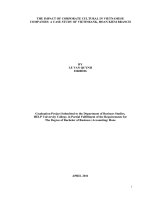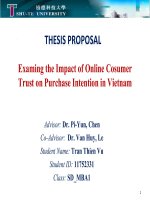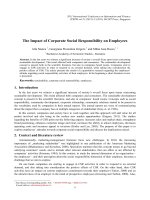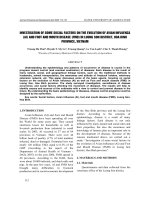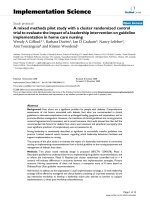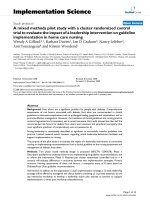Management perception of the impact of corporate social responsibility on corporate reputation in Vietnam
Bạn đang xem bản rút gọn của tài liệu. Xem và tải ngay bản đầy đủ của tài liệu tại đây (901.44 KB, 97 trang )
MINISTRY OF EDUCATION AND TRAINING
UNIVERSITY OF ECONOMICS HO CHI MINH CITY
------------
BÙI THỊ DIỄM NGA
MANAGEMENT PERCEPTION OF THE IMPACT
OF CORPORATE SOCIAL RESPONSIBILITY ON
CORPORATE FINANCIAL PERFORMANCE
AND CORPORATE REPUTATION
IN VIETNAM
MASTER THESIS
HO CHI MINH CITY – 2013
MINISTRY OF EDUCATION AND TRAINING
UNIVERSITY OF ECONOMICS HO CHI MINH CITY
------------
BÙI THỊ DIỄM NGA
MANAGEMENT PERCEPTION OF THE IMPACT
OF CORPORATE SOCIAL RESPONSIBILITY ON
CORPORATE FINANCIAL PERFORMANCE
AND CORPORATE REPUTATION
IN VIETNAM
Subject: Master of Business Administrator
Code: 06.34.01.02
MASTER THESIS
SUPERVISOR:
DR. NGUYỄN THỊ NGUYỆT QUẾ
HO CHI MINH CITY – 2013
I
ACKOWLEDGMENT
First of all, I would like to indicate my deep gratitude to Dr. Nguyen Thi Nguyet
Que, my promoter. Throughout the entire research, she offered valuable advice,
helpful guidance and comments as well as encouragement during difficult times. I
sincerely appreciate you, both personally and professionally.
I am also grateful to my classmates who were unfailingly kind, offered ongoing
encouragement, and helped me whenever it was necessary.
In addition, I‟d like to send my special thanks to all of my colleagues- Ms. Tien,
Ms. Loan, Ms. Thu and my director- Ms. Nguyen Vu Thanh Uyen at Dang Hung
Chemical Company for your persistent support, encouragement. Without your help,
my dissertation couldn‟t be finished in time.
I will be forever indebted to my beloved family members, especially my parents and
my parents-in-law. They have supported me in a consistently loving manner.
I am especially grateful to my husband, Kim Do, for his love, thoughtfulness, and
endless support. Thanks for looking after our daughter- Lucie so well whenever I
were busy and focus on this dissertation.
Lucie, thank you so much for your precious existence in my life! While it is true
that you make my life increasingly busy. Without you, my life would have no
meaning at all.
Once again, I extend my profound thanks to all of you, as well as to others whose
names are not mentioned here but who also contributed directly or indirectly to this
thesis.
Bui Thi Diem Nga
Ho Chi Minh City, 26 September, 2013
II
COMMITMENT
I certify that the ideas, analyses, and conclusions reported in this thesis
“Management Perception Of The Impact Of Corporate Social Responsibility On
Corporate Financial Performance And Corporate Reputation In Vietnam” are
entirely my own effort. The data was collected in reality and it has clear origins. I
also certify that the work is original and has not been previously submitted for any
other award.
III
TABLE OF CONTENT
ACKOWLEDGMENT ............................................................................................. I
COMMITMENT ......................................................................................................II
LIST OF FIGURES ............................................................................................... VI
LIST OF TABLES ................................................................................................VII
ABSTRACT ...............................................................................................................1
CHAPTER 1: INTRODUCTION ............................................................................3
1.1 Research background .........................................................................................3
1.2 Research Issues, Objectives & Questions .........................................................4
1.3 Research methodology ........................................................................................5
1.4 Significance of study ...........................................................................................5
1.5 Structure of study ................................................................................................6
CHAPTER 2: LITERATURE REVIEW: ..............................................................7
2.1 Introduction .........................................................................................................7
2.2 Concept of Corporate Social Responsibilities ..................................................7
2.2.1 Definition of Corporate Social responsibility ................................................7
2.2.2 CSR components ............................................................................................11
2.3 Review of previous studies on CSR and organization performance ............12
2.3.1 Related CSR and financial performance .....................................................13
2.3.2 Related to CSR and corporate reputation ...................................................15
2.4 Development of theoretical model and research hypothesis .........................21
2.4.1 CSR and Financial performance ..................................................................22
IV
2.4.2 CSR and corporate reputation......................................................................25
2.5 Summary ............................................................................................................28
CHAPTER 3: RESEARCH METHOD ................................................................ 29
3.1 Introduction: ......................................................................................................29
3.2 Research design .................................................................................................29
3.3. Questionnaire development .............................................................................31
3.3.1 Scale of independent variables ......................................................................31
3.3.2 Scale of dependent variables .........................................................................32
3.3.3 Translation of the Questionnaire ..................................................................35
3.4. The pilot study ..................................................................................................35
3.5 Main survey .......................................................................................................36
3.5.1 Target population ...........................................................................................36
3.5.2 Sample method ...............................................................................................36
3.5.3 Sample size ......................................................................................................37
3.5.4 Questionnaire administration .......................................................................37
3.6 Methods of data analysis ..................................................................................38
3.7 Summary ............................................................................................................40
CHAPTER 4: DATA ANALYSIS .........................................................................41
4.1 Introduction .......................................................................................................41
4.2 Descriptions of sample .....................................................................................41
4.3. Reliability and validity of the measurement scale .......................................42
4.3.1. Reliability (Cronbach Alpha) .......................................................................42
4.3.2. Exploratory factor analysis (EFA) ..............................................................44
V
4.4 Testing the research model and the hypotheses .............................................47
4.4.1 Testing correlations of constructs .................................................................48
4.4.2. Regression Analysis.......................................................................................51
4.4.3 Test the violations of assumptions in linear regression ..............................58
4.5. Conclusion .........................................................................................................58
CHAPTER 5: CONCLUSION AND IMPLICATION ........................................60
5.2 Discussion of findings ........................................................................................60
5.2.1. The impact of CSR activities in term of employee responsibilities on
financial performance and corporate reputation .................................................61
5.2.2 The impact of CSR activities in term on community responsibilities on
financial performance and corporate reputation .................................................62
5.2.3. The impact of CSR activities in term of customer responsibilities on
financial performance and corporate reputation. ................................................63
5.2.4 The impact of CSR activities in term of environment responsibilities on
financial performance and corporate reputation .................................................64
5.3 Practical implications and contribution of study ...........................................64
5.4 Limitation and future research ........................................................................66
5.5 Conclusion ..........................................................................................................67
LIST OF REFERENCE .........................................................................................67
APPENDIX A .........................................................................................................73
APPENDIX B .........................................................................................................78
APPENDIX C ..........................................................................................................81
APPENDIX D ..........................................................................................................83
VI
LIST OF FIGURES
Figure
Description
Page
Figure 2.1
Research Model
28
Figure 2.2
Research process
30
Figure 4.4
The revised research model
57
VII
LIST OF TABLES
Table
Description
Page
Table 2.1
Definitions of CSR – academic research
8
Table 2.2
Definitions of CSR based on representatives organizations
9
Table 2.3
Abstract of CSR researches
17
Table 3.1
Items of variables in the study
33
Table 4.1
Sample characteristics
42
Table 4.2
Reliability of scales
43
Table 4.3
KMO and Barlett's Test of independent variables
45
Table 4.4
Rotated Component Matrix(a)
45
Table 4.5
Item-Total Statistics
46
Table 4.6
KMO and Bartlett's Test
47
Table 4.7
Rotated Component Matrixa
47
Table 4.8
Correlations of MLR (1)
49
Table 4.9
Correlations of MLR (2)
50
a
Table 4.10
Variables Entered/Removed
Table 4.11
Model Summary
51
Table 4.12
ANOVAa
52
Table 4.13
Coefficientsa (MLR -1)
52
Table 4.14
Model Summaryb
54
Table 4.15
ANOVA
a
51
55
a
Table 4.16
Coefficients
Table 5.1
Research Purposes, Hypotheses and Results
55
61
1
ABSTRACT
Nowadays, the Vietnamese business community has been facing with important
issues for its sustainable development, especially societal and environmental
including energy saving, waste management, workplace safety standards, take care
of its employee and so on. Recent numerous cases of health safety problems
especially tainted milk distribution, toxic ingredients found out in food, consumer
goods,…, have been raising a greater concern on Corporate Social Sesponsibility
(here in after refered to as CSR) in Vietnam. Beside that, Vietnamese exportoriented companies have been also encountering problems of good citizenship when
their foreign investors and buyers require them to take business practices based on
respect for people, communities and the environment.
Corporate social responsibility (here in after referred to as CSR) has been
considered as non-tariff barriers and challenging to the developing countries
including Vietnam. Being aware of the important of CSR and the impact of it on the
organization performance are necessary to help organization overcome these
invisible barriers as well as to have a suitable investment on CSC activities.
There are many researches examining the impact of CSR activities on the
organization performance in the world. They are investigated not only in developed
countries but also in developing countries. The result of these researches show the
positive, negative or neutral impact, however, most of these researches find the
positive impact of CSR activities on organization performance. Other two known
researches which are investigated in emerging economic also show the positive
relationship between CSR and organization performance, in other word, CSR can
bring determined advantages for organization.
In Vietnam, CSR is still new concept not only toward customer but also toward
Vietnamese enterprise. Based on the attitudes of CSR experts, because the lack of
in-depth knowledge and professional research about CSR in Vietnam has led to
2
incomplete provided information, which then turns into inaccurate news and articles
that can influence consumers, governments and enterprises as well. Therefore it‟s
essential to raise the level of awareness of CSR and their roles in Vietnam. That is
the reason to implement this study.
This study aims to examine the perception of managers of the impact of CSR on
organization performance in terms of financial performance and corporate
reputation. This relationship between corporate social responsibility activity and
organizational performance attracts the interest of significant stakeholder groups
(customer, employee, community and environment). Research was conducted in
Southern Vietnam which main concentrate at Hochiminh city, Binh Duong
province, Dong Nai province and somewhere else near to HCMC. The results of the
study find that CSR activities in environment have positive impact on financial
performance of organization. In addition implementation of CSR toward
environment and customer has positive effect on corporate reputation as well.
3
CHAPTER 1: INTRODUCTION
1.1 Research background
The ongoing globalization has made people, capital and goods move quickly around
the world and easier access information and communication. A large part of
international enterprises move their investment in to developing countries to save
production cost and take advantage from local market. This transformation brings
not only many new opportunities and advantages but also new challenge to the
developing countries including Vietnam. For the challenge, after joining to the
World Trade Organization Vietnam must to invest more in environment policies,
legal framework and especially CSR activities because of strict requirements from
partner and international organization. Furthermore, societal and environmental
issues rise during the last few years in Vietnam are considered worldwide as
corporate social responsibility that businesses should commit to their stakeholders
such as the community, employees, and customers for the sake of positive long term
benefits.
In 2007, Vietnam Chamber of Commerce and Industry (VCCI) had a report to
evaluating status CSR in Vietnam. This report shows that CSR still a new concept
in Vietnam, it fist introduced to Vietnam in form of Code of Conduct or Social
standard requirements (VCCI, 2007). In Vietnam, CSR is applied firstly in footwear
and apparel industries (VCCI, 2007) after that it is extended to the other sectors. In
a report of VCCI regarding to the CSR in Vietnam in year 2011, CSR is still the hot
issue which is considered in terms of environmental issues (water/ air pollution…),
social responsibilities (human right, poverty rate…) and ethical issue (fight against
corruption). There are some barriers to implementation CSR in Vietnam. According
to VCCI (2011), barriers can be listed such as lack of awareness of the relative actor
and hierarchy preference, lack of support from government, limit in resource, lack
of CSR model for Vietnam…Furthermore some Vietnamese companies assume that
CSR should be only for big companies or for international company only. Therefore
4
it is importance to change their mindset from “CSR as a cost” to “CSR as an
investment”. To do this thing, it needs more studies to investigate the impact of
CSR in Vietnamese enterprises.
There are many researches in the world show the positive impact of CSR on
organization performance in term of financial performance and corporate reputation
(Taneja et al. 2011, p. 351), it is not only true to the developed countries but also for
the developing countries. We do this research aims to examine this relationship in
Vietnam based on the managerial perception in Vietnam. The result from this
research will bring a clear insight about CSR in Vietnam then we will have more
facilitate to make decision in implementation CSR in Vietnam.
1.2 Research Issues, Objectives & Questions
Knowing thoroughly CSR and their benefit in Vietnam are still big questions which
are concerned by many enterprises, governmental organizations and consumer as
well. This study aims to answer the following questions:
1. Is there a positive association between CSR activities and financial
performance?
2. Is there a positive association between CSR activities and corporate
reputation?
3. To which extent category of CSR activities impacts on financial performance
and corporate reputation?
This study examines the impact of each category of CSR activities on organization
performance in terms of financial performance and corporate reputation.
Categorization of CSR activities in this study is based on the approach of CSR to
different stakeholder groups. There are four categories of CSR activities which
include CSR toward employee, customer, community and environment. The
objectives of this study are:
5
-
To examine the impact of CSR activities including community
responsibilities, employee responsibilities, customer responsibilities and
environment responsibilities on financial performance.
-
To examine the impact of CSR activities including community
responsibilities, employee responsibilities, customer responsibilities and
environment responsibilities on corporate reputation.
In addition, the objective of this research is to understand the meaning and
importance of CSR in Vietnam so that they can help managers and professionals
elaborate an effective integrated communication strategy to meet the requirements
of investor and customer and to enhance their company‟s sustainable reputation.
1.3 Research methodology
This research is conducted in the Southern Vietnam where numbers of enterprises
operate hear. The research process includes two main steps. First step is pilot test by
in-depth interview with managers to modify the scale to be appropriate for Vietnam.
The second step is main study which the quantitative research method is applied.
Convenience sampling method is used by sending hard copy and soft copy via
email to respondents.
The Statistical Package for the Social Sciences (SPSS0) software version 20 is used
to analysis in this study. The scale of variables is verified by Cronbach Alpha for
the reliability and Exploratory factor analysis (EFA) for validity. After verifying the
scale, two model of Multilinear Regression are applied to examine the impact of
each category of CSR activities on financial performance and corporate reputation.
1.4 Significance of study
This study aim to finding the relationship between CSR activities and organization
performance in terms of financial performance and corporate reputation in Vietnam
thence it brings a clear insight about CSR in Vietnam to make decision in
implementation CSR.
6
This research contributes to the literature regarding the CSR activities and their
impacts in Vietnam. In addition, this study is expected to help enterprises,
researchers, regulators, and stakeholders in Vietnam comprehend the impact of CSR
activities on the organization performance.
1.5 Structure of study
This research is divided into five chapters.
Chapter 1 – Introduction: This chapter presents the purpose of research, research
objectives and questions, research method and structure of study.
Chapter 2 – Literature review: It reviews CSR definitions and their categories as
well as these researches regarding impact of CSR activities on organization
performance.
Chapter 3 – Research method: It presents the method to collect data, evaluate scale
and data analysis which are used in this study.
Chapter 4 – Data analysis and finding: It discusses about the result of analyzing data
in this study.
Chapter 5 – Conclusion: This chapter discusses in detail about the finding of study,
significant and limitation of this study and recommendation for further researches.
1.6 Conclusion:
Chapter 1 presents brief overview about this thesis which include research
objectives and questions, purpose of research, structure of research and signification
of research.
7
CHAPTER 2: LITERATURE REVIEW:
2.1 Introduction:
This chapter reviews the literature on CSR and the relationship between CSR and
organizational performance. The concept and components of CSR is also discussed
in this chapter. Author also reviews previous studies for the CSR and organizations
performance in term of financial performance and corporate reputation.
2.2 Concept of Corporate Social Responsibilities
2.2.1 Definition of Corporate Social responsibility
CSR is an abstract definition and it is defined in many ways and no universal
accepted definition (Kakabadse et al. 2005 p.280). The different may come from
literary translation, employ, promote or interpretation by the people within (or
outside) the CSR field. For this reason it is still no unified CSR definition and still
lack of general platform to assert legitimacy, creditability and value of research
which is accepted by majority development (Kakabadse et al. 2005 p.280).
Abundance of CSR definitions is a problem because it is not representative to all
therefore prevent the development and implementation of the concept (Van
Marrewijk, 2003).
CSR is defined by International Organizations, academics, or policy maker. The
concept of CSR is often put into the relation with the other concept such as
corporate social performance or sustainability but it concentrates in expression
social‟s expectation as a role and responsibilities of business. (Kakabadse et al.
2005, p.280). In the research of Kakabadse et al. (2005), definitions of CSR which
are defined by academic researches and organizations are listed in the below table:
8
Table 2.1: Definitions of CSR – academic research
Author of the
The concept outline
definition
Drucker
It is impossible to base any longer on the assumption that the owner‟s
(1992, p. 408)
personal interest will lead him to the general interest and that the
personal and the general interest can be separated and treated as
categories that have nothing in common. Is quite the opposite: this
responsibility requires from a manager taking over the responsibility
for the general interest, subordinating his actions to ethical norms,
limiting his own interest and authority in the event their realization
was to turn against this general interest and an individual‟s freedom.
Friedman (1997, p. 59)
There is only one type of social responsibility in the world of business
– use one‟s resources and conduct operations with a view to
increasing one‟s resources as long as this increasing remains in
conformity with the game rules. In other words, one should get
involved only in open and free competition without any tricks and
fraud.
Griffin
Social responsibility is a set of commitments on the side of the
(1999, p. 144)
company to protect and strengthen the community within which it
functions.
Żemigała
Acontemporary company should be an organisation that serves its
(2007, p. 9)
environment since it realises apart from economic tasks also social
tasks including environmental ones. Companies should bear
responsibility for social progress and for what is related to it – the
natural environment.
Lisiecka
Corporate social responsibility concerns, among other things, limiting
(2003, p. 13)
and ceasing any actions that are socially and physically harmful,
providing goods and services where a profit cannot be made
(communal services), taking responsibility for positive social
progress.
Urbaniak
Corporate social responsibility is a concept being the realisation of the
9
(2007, p. 11)
implementation of the sustained (permanent) development with the
consideration of economic, environmental and social aspects.
Kawka- Tomczak
Socially responsible business is, in particular, a strategic partnership
(3/2003 p. 55)
committed to building an adequate image of the company and its
activity. This is also a philosophy of doing business, shaping relations
between all stakeholders, that is the cooperation between employees,
customers, suppliers, stockholders, competitors, local community, and
state administration
Maignan
&
Ferrell The implementation of CSR does not consist of the launching of a few
(2004)
benevolent initiatives such as philanthropy programs, environmental
protection policies, or employee-friendly practices. Instead, to enact
their commitment to CSR, businesses must embrace a solid set of
principles and processes that can help to systematically address
stakeholder demand and secure stakeholder support.
Source: Walkowiak (2009, p. 11).
Table 2.2: Definitions of CSR based on representatives organizations.
Organization
Definition
Business Corporate Social Responsibility is business‟ commitment to
World
Council for Sustainable contribute to sustainable economic development working with
Development
employees, their families, the local community, and society at
(WBCSD) (2003)
large to improve their quality of life.
CSR Europe (2003)
Corporate Social Responsibility is the way in which a company
manages and improves its social and environmental impact to
generate value for both its shareholders and its stakeholders by
innovating its strategy, organization and operations.
Organization
for Corporate Responsibility involves the „fit‟ businesses develop
Economic Co-operation with the societies in which they operate. The function of
and
Development business in society is to yield adequate returns to owners of
(OECD) (2003)
capital by identifying and developing promising investment
10
opportunities and, in the process, to provide jobs and to produce
goods and services that consumers want to buy. However,
corporate responsibility goes beyond this core function.
Businesses are expected to obey the various laws which are
applicable to them and often have to respond to societal
expectations that are not written down as formal law.
Amnesty International Companies [have] to recognize that their ability to continue to
– Business Group (UK) provide goods and services and to create financial wealth will
(2002)
depend on their acceptability to an international society which
increasingly regards protection of human rights as a condition of
the corporate license to operate.
The
Corporate As an „organ of society‟, companies have a responsibility to
Responsibility
Coalition
safeguard human rights within their direct sphere of operations
(CORE) as well as within their wider spheres of influence.
(2003)
Novethic (2003)
Linked to the application by corporations of the sustainable
development principle, the concept of CSR integrates three
dimensions: an economic dimension (efficiency, profitability), a
social dimension (social responsibility) and an environmental
dimension (environmental responsibility). To respect these
principles, corporations must pay more attention to all the
stakeholders which inform on the expectations of civil society
and the business environment.
Novo Nordisk (2003)
Social responsibility for Novo Nordisk is about caring for
people. This applies to our employees and the people whose
healthcare needs we serve. It also considers the impact of our
Source: Kakabadse et al. 2005
Dahlsrud (2008) review the context in which definition of CSR existing and find
that definitions are divided into five dimensions as stakeholder, social, environment,
11
voluntary and economic dimension. The stakeholder theory is one of the most
important to approach CSR and it has been used in many areas (Bayoud et al.
2012). Definition of CSR of Maignan & Ferrell (2004) is chosen in this research
because it considers CSR activities to stakeholder demands. Moreover, this research
carry out CSR activities to stakeholder in term of managerial perception thus author
uses CSR definition of Maignan and Ferrell (2004) in this research.
To sum up, the definition of CSR should be flexible, met over time and server
particular purpose in order to improve organization performance. (Bayoud et al.
2012). CSR is approached by different dimensions but the stakeholder theory is
used more.
2.2.2 CSR components
In general CSR includes of four categories of information, they relate to
environmental, consumer, employee and community involvement information
(Bayoud et al. 2012). Report of CSR in organization which is sent to stakeholder
often includes activities toward environment, customer, community, employee,
shareholder (investor) and external stakeholder such as supplier.
Environmental responsibilities:
CSR in environment mentions about the implementation of organization to political
environment (Bayoud et al. 2012). Environment disclosure includes the following
items: waste management, measure and access the environment programs, energy
conservation activities, emission level control and environmental audit
Community responsibilities:
Based on studies of Bayoud et al. (2012) and Rettab et al. (2009), Corporate social
responsibility in term of community relate to activities to support community where
organization operate. Community responsibilities encompass the following items:
financial support to local school where organization operate, financial support to
12
community activities, help to improve quality of life in community and charity and
donation policies.
Employee responsibilities:
Corporate social responsibility to employee is activities of organization which
impact on employee (Bayoud et al 2012). According to Bayoud et al (2012); Rettab
et al. (2009) and Maignan & Ferrell (2004), responsiveness to employee includes
employee health, safety programs, employee education/training, working condition
and treating employee fairly and respectfully.
Customer responsibilities:
In CSR, customer is one of the most importance issue need to be concerned due to
the quality aspect and stakeholder right (Bayoud et al 2012). The activities of CSR
toward customer which are examined by Bayoud et al (2012), and Rettab et al.
(2009) include these actions: providing good quality product and clear information
needed to customer to make purchasing decision, satisfying customer complains
about product/service of company, improving product/service to enhance customer
satisfaction and reliability.
2.3 Review of previous studies on CSR and organization performance
CSR is one of the hot topics which is interested by many researchers in the world
especially in recent years. To summarize these announced CSR researches from
year of 1970 to 2008, Taneja et al. (2011) do a research for this. Authors find that
the number of CSR research significant increase from 2001 to 2008. Most of
methodology of reviewed researches is qualitative method, however, the research
trend move from qualitative to quantitative in recent time (Taneja et al. (2011). CSR
researches which are reviewed in the research of Taneja et al. (p.259, 2011) are
grouped into five major: definition of CSR, CSR model, factor determining CSR
initiatives, CSR in action and the impact of CSR on the organization performance.
My research is also in these groups.
13
There are many researches to examine the impact of CSR on the organization
performance (Luu, 2012; Bayoud et al. 2012; Orlitzky et al. 2003; Schniet &
Epstein 2005; Wright & Ferris 1997; Bayoud et al. 2012; Nelling & Webb 2009;
Rettab et al. 2009; Michiel 2006; McGuire & Schneeweis 1988), the above
researches find that there is a relationship between CSR and organization
performance which has positive, negative, mixed or no-significant results. In other
side, some of these researches find the positive relationship between CSR and
organization performance (Luu 2012; Rettab, et al. 2009; Bayoud et al. 2012).
Furthermore, Rettab et al. (2009) points out in their study that it has a positive
relationship between CSR and organization in term of financial performance,
corporate reputation and employee commitment in Dubai - an emerging economic.
In Vietnam, there is also have some studies in CSR however, most of them
concentrate in the evaluation of CSR practices in Vietnam (Pham 2010; Tran 2009;
Nguyen 2008; Ho 2008; Shizuo Fukada 2007; Charlotta Undén 2007). On the other
hand, it also has a research to examine the linkage between CSR and brand equity in
healthcare service in Vietnam (Luu 2012). In this study, Luu (2012) find that
implement ethical CSR initiatives such as charity check-up, charity surgery, and
healthcare programs for pupils, will be placed in a competitive position in the
marketplace and thus be able to build successful and differentiated brand equity
(Luu 2012). Luu (2012) find there is no clear link between legal CSR, economic
CSR and brand equity as well.
In Vietnam, it is still lack of research to measure the impact of CSR on the
organization performance and the perception of manager for this issue.
2.3.1 Related CSR and financial performance
Based on Orlitzky et al. (2003), financial performance is considered one of the most
importance indicators of the strategic value of CSR. Financial performance is the
main objective which is used by investor to examining corporate portfolio and
14
evaluating the way corporate meet their social responsibility (Barnett & Salomon
2006). This is the reason corporate shift their attention on financial orientation
including with CSR activities. This increases the debate over whether CSR affect on
financial performance in term of employee commitment, firm‟s share price, its
consumer support (Bayoud et al. 2012). Moreover, orientation and attention of
corporate in priority CSR practice can lead to conflicting in the demand of each
stakeholder group therefore understanding the relationship between CSR and
financial performance is really importance for managers to keep balance
stakeholder expectation and demand (Bayoud et al. 2012). McGuireet al. (1988),
Michiel (2006), Rettab et al. (2009) point out principle impact of CSR on financial
performance such as increasing productivity based on improvement employee‟s
moral, save cost associated recruitment, training, recycle programs, enhance
satisfaction of stakeholder…
There are two types of empirical study to test the relationship between CSR and
financial performance (Bayoud et al. 2012). First type is event study methodology
to examine the short-term impact and the second type is market based-measure of
financial performance such as firm‟s share price to test the long-term impact.
Previous studies of relationship between CSR and financial performance have
concluded the beneficial effect, negative effect or no relationship but most of them
are positive impact (Margolis & Walsh 2003). Margolis & Walsh (2003) statistic
that four percent of 160 reviewed studies find the negative relationship between
CSR and Financial performance, fifty five percent find the positive relationship and
twenty two percent find no relationship. McGuire& Schneeweis (1988) find that
each component of financial performance is different affected by CSR for example,
the return on asset and total asset have positive relation with CSR in the mean
while, operating income growth has negative correlation with CSR. In another
research of the impact of CSR on financial performance of Bayoud et al. (2012)
find that each component of CSR activities have positive impact on financial
15
performance in different level such as significant, strong link or no doubt. Rettab et
al. (2009) examining firms in the UAE market as an emerging economy the result
of this research find the positive relationship between CSR and financial
performance. The research of Bayoud et al. (2012) is considered the latest study
which is reviewed in this study regarding to CSR and corporate social and financial
performance, it also find the positive relationship between them.
2.3.2 Related to CSR and corporate reputation
It has much research to define corporate reputation (Bayoud et al. (2012), p. 85).
Siltaoja (2006, p. 91) give the definition of corporate reputation as follow:
“[T]he most important competitive advantage that companies can have assessments
about what the organization is, how well it meets its commitments and conforms to
stakeholders‟ expectations, how effectively its overall performance fits with its
socio-political environments.”
In term of CSR and corporate reputation, CSR create reputation for firm which
makes reliability and honest (McWilliams & Siegel (2000). In addition, Bebbington
& Moneva (2008) show that in time of crisis, “CSR can build a reservoir of
goodwill that firm can draw up”. Regarding to the research of relationship between
CSR and corporate reputation, Branco et al. (2006) find that CSR disclosure is
particularly importance in enhancing impact of CSR on corporate reputation.
Branco also show that improving relationship with external stakeholder such as
supplier, investor, customer and competitor and internal stakeholder is related to
having a good reputation for good social responsibility. Research of Bayoud et al.
(2012) and Rettab et al. (2009) also find the positive relationship between CSR and
corporate reputation in Libya, this suggest that relationship between CSR and
corporate reputation not only right to the developed countries but also for the
developing countries.

